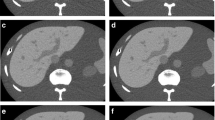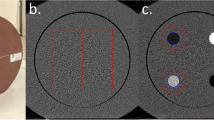Abstract
Objectives
To assess the impact on image quality and dose reduction of a new deep learning image reconstruction (DLIR) algorithm compared with a hybrid iterative reconstruction (IR) algorithm.
Methods
Data acquisitions were performed at seven dose levels (CTDIvol : 15/10/7.5/5/2.5/1/0.5 mGy) using a standard phantom designed for image quality assessment. Raw data were reconstructed using the filtered back projection (FBP), two levels of IR (ASiR-V50% (AV50); ASiR-V100% (AV100)), and three levels of DLIR (TrueFidelity™ low, medium, high). Noise power spectrum (NPS) and task-based transfer function (TTF) were computed. Detectability index (d′) was computed to model a large mass in the liver, a small calcification, and a small subtle lesion with low contrast.
Results
NPS peaks were higher with AV50 than with all DLIR levels and only higher with DLIR-H than with AV100. The average NPS spatial frequencies were higher with DLIR than with IR. For all DLIR levels, TTF50% obtained with DLIR was higher than that with IR. d′ was higher with DLIR than with AV50 but lower with DLIR-L and DLIR-M than with AV100. d′ values were higher with DLIR-H than with AV100 for the small low-contrast lesion (10 ± 4%) and in the same range for the other simulated lesions.
Conclusions
New DLIR algorithm reduced noise and improved spatial resolution and detectability without changing the noise texture. Images obtained with DLIR seem to indicate a greater potential for dose optimization than those with hybrid IR.
Key Points
• This study assessed the impact on image quality and radiation dose of a new deep learning image reconstruction (DLIR) algorithm as compared with hybrid iterative reconstruction (IR) algorithm.
• The new DLIR algorithm reduced noise and improved spatial resolution and detectability without perceived alteration of the texture, commonly reported with IR.
• As compared with IR, DLIR seems to open further possibility of dose optimization.





Similar content being viewed by others
Abbreviations
- AiCE:
-
Advanced intelligent Clear-IQ Engine
- AV or ASiR-V:
-
Next generation of adaptative statistical iterative reconstruction algorithm
- CTDIvol :
-
Volume CT dose index
- DLIR:
-
Deep learning image reconstruction
- DNN:
-
Deep neural network
- FBP:
-
Filtered back projection
- IQ:
-
Image quality
- IR:
-
Iterative reconstruction
- MBIR:
-
Model-based image reconstruction
- NPS:
-
Noise power spectrum
- TCM:
-
Tube current modulation
- TTF:
-
Task-based transfer function
References
Brenner DJ, Hall EJ (2007) Computed tomography--an increasing source of radiation exposure. N Engl J Med 357:2277–2284
Greffier J, Pereira F, Macri F, Beregi JP, Larbi A (2016) CT dose reduction using automatic exposure control and iterative reconstruction: a chest paediatric phantoms study. Phys Med 32:582–589
Beregi JP, Greffier J (2019) Low and ultra-low dose radiation in CT: opportunities and limitations. Diagn Interv Imaging 100:63–64
Greffier J, Frandon J, Larbi A, Beregi JP, Pereira F (2019) CT iterative reconstruction algorithms: a task-based image quality assessment. Eur Radiol. https://doi.org/10.1007/s00330-019-06359-6
Willemink MJ, Noel PB (2019) The evolution of image reconstruction for CT-from filtered back projection to artificial intelligence. Eur Radiol 29:2185–2195
Katsura M, Matsuda I, Akahane M et al (2012) Model-based iterative reconstruction technique for radiation dose reduction in chest CT: comparison with the adaptive statistical iterative reconstruction technique. Eur Radiol 22:1613–1623
Yamada Y, Jinzaki M, Hosokawa T et al (2012) Dose reduction in chest CT: comparison of the adaptive iterative dose reduction 3D, adaptive iterative dose reduction, and filtered back projection reconstruction techniques. Eur J Radiol 81:4185–4195
Larbi A, Orliac C, Frandon J et al (2018) Detection and characterization of focal liver lesions with ultra-low dose computed tomography in neoplastic patients. Diagn Interv Imaging 99:311–320
Macri F, Greffier J, Khasanova E et al (2019) Minor blunt thoracic trauma in the emergency department: sensitivity and specificity of chest ultralow-dose computed tomography compared with conventional radiography. Ann Emerg Med 73:665–670
Tang H, Liu Z, Hu Z et al (2019) Clinical value of a new generation adaptive statistical iterative reconstruction (ASIR-V) in the diagnosis of pulmonary nodule in low-dose chest CT. Br J Radiol. https://doi.org/10.1259/bjr.20180909:20180909
Kim HG, Lee HJ, Lee SK, Kim HJ, Kim MJ (2017) Head CT: image quality improvement with ASIR-V using a reduced radiation dose protocol for children. Eur Radiol 27:3609–3617
Han WK, Na JC, Park SY (2019) Low-dose CT angiography using ASiR-V for potential living renal donors: a prospective analysis of image quality and diagnostic accuracy. Eur Radiol. https://doi.org/10.1007/s00330-019-06423-1
Tenant S, Pang CL, Dissanayake P et al (2017) Intra-patient comparison of reduced-dose model-based iterative reconstruction with standard-dose adaptive statistical iterative reconstruction in the CT diagnosis and follow-up of urolithiasis. Eur Radiol 27:4163–4172
Verdun FR, Racine D, Ott JG et al (2015) Image quality in CT: from physical measurements to model observers. Phys Med 31:823–843
Ott JG, Becce F, Monnin P, Schmidt S, Bochud FO, Verdun FR (2014) Update on the non-prewhitening model observer in computed tomography for the assessment of the adaptive statistical and model-based iterative reconstruction algorithms. Phys Med Biol 59:4047–4064
Samei E, Richard S (2015) Assessment of the dose reduction potential of a model-based iterative reconstruction algorithm using a task-based performance metrology. Med Phys 42:314–323
Geyer LL, Schoepf UJ, Meinel FG et al (2015) State of the art: iterative CT reconstruction techniques. Radiology 276:339–357
Greffier J, Frandon J, Pereira F et al (2019) Optimization of radiation dose for CT detection of lytic and sclerotic bone lesions: a phantom study. Eur Radiol. https://doi.org/10.1007/s00330-019-06425-z
Qi D, Hao C, Lequan Y et al (2016) Automatic detection of cerebral microbleeds from MR images via 3D convolutional neural networks. IEEE Trans Med Imaging 35:1182–1195
Roth HR, Lu L, Seff A et al (2014) A new 2.5D representation for lymph node detection using random sets of deep convolutional neural network observations. Med Image Comput Comput Assist Interv 17:520–527
Powell S, Magnotta VA, Johnson H, Jammalamadaka VK, Pierson R, Andreasen NC (2008) Registration and machine learning-based automated segmentation of subcortical and cerebellar brain structures. Neuroimage 39:238–247
Akagi M, Nakamura Y, Higaki T et al (2019) Deep learning reconstruction improves image quality of abdominal ultra-high-resolution CT. Eur Radiol 29:6163–6171
JHsieh J, Liu E, Nett B, Tang J, Thibault JB, Sahney S (2019) A new era of image reconstruction: TrueFidelity™. Technical white paper on deep learning image reconstruction. GE Healthcare
Wu D, Kim K, Li Q (2019) Computationally efficient deep neural network for computed tomography image reconstruction. Med Phys 46:4763–4776
Nakamura Y, Higaki T, Tatsugami F et al (2019) Deep learning–based CT image reconstruction: initial evaluation targeting hypovascular hepatic metastases. Radiol Artif Intell 1:e180011
Thibault JB, Sauer KD, Bouman CA, Hsieh J (2007) A three-dimensional statistical approach to improved image quality for multislice helical CT. Med Phys 34:4526–4544
McCollough CH, Chen GH, Kalender W et al (2012) Achieving routine submillisievert CT scanning: report from the summit on management of radiation dose in CT. Radiology 264:567–580
Solomon J, Zhang Y, Wilson J, Samei E (2018) An automated software tool for task-based image quality assessment and matching in clinical CT using the TG-233 framework. Med Phys 45:E134–E134
Samei E, Bakalyar D, Boedeker KL et al (2019) Performance evaluation of computed tomography systems: summary of AAPM task group 233. Med Phys 46:e735–e756
McCollough CH, Yu L, Kofler JM et al (2015) Degradation of CT low-contrast spatial resolution due to the use of iterative reconstruction and reduced dose levels. Radiology 276:499–506
Jensen CT, Wagner-Bartak NA, Vu LN et al (2019) Detection of colorectal hepatic metastases is superior at standard radiation dose CT versus reduced dose CT. Radiology 290:400–409
Christianson O, Chen JJ, Yang Z et al (2015) An improved index of image quality for task-based performance of CT iterative reconstruction across three commercial implementations. Radiology 275:725–734
Kwon H, Cho J, Oh J et al (2015) The adaptive statistical iterative reconstruction-V technique for radiation dose reduction in abdominal CT: comparison with the adaptive statistical iterative reconstruction technique. Br J Radiol 88:20150463
Chen LH, Jin C, Li JY et al (2018) Image quality comparison of two adaptive statistical iterative reconstruction (ASiR, ASiR-V) algorithms and filtered back projection in routine liver CT. Br J Radiol 91:20170655
Goodenberger MH, Wagner-Bartak NA, Gupta S et al (2018) Computed tomography image quality evaluation of a new iterative reconstruction algorithm in the abdomen (adaptive statistical iterative reconstruction-V) a comparison with model-based iterative reconstruction, adaptive statistical iterative reconstruction, and filtered back projection reconstructions. J Comput Assist Tomogr 42:184–190
Acknowledgments
We thank the Centre Cardiologique du Nord for giving us the permission to use their measurement results. We thank S. Kabani for her help in editing the manuscript.
Funding
The authors state that this work has not received any funding.
Author information
Authors and Affiliations
Corresponding author
Ethics declarations
Guarantor
The scientific guarantor of this publication is Jean Paul Beregi.
Conflict of interest
One author declares relationship with the following company: GE Healthcare. Hugo Pasquier is a GE Healthcare employee. However, he neither had access nor control on the phantom data acquisition and analysis.
All other authors of this manuscript declare no relationships with any companies whose products or services may be related to the subject matter of the article.
Statistics and biometry
No complex statistical methods were necessary for this paper.
Informed consent
Written informed consent was not required for this study because it is a study phantom.
Ethical approval
Institutional Review Board approval was not required because it is a study phantom.
Study subjects or cohorts overlap
No study subjects or cohorts have been previously reported.
Methodology
• Experimental
• Performed at one institution
Additional information
Publisher’s note
Springer Nature remains neutral with regard to jurisdictional claims in published maps and institutional affiliations.
Supplementary materials
ESM 1
(DOCX 27 kb)
Rights and permissions
About this article
Cite this article
Greffier, J., Hamard, A., Pereira, F. et al. Image quality and dose reduction opportunity of deep learning image reconstruction algorithm for CT: a phantom study. Eur Radiol 30, 3951–3959 (2020). https://doi.org/10.1007/s00330-020-06724-w
Received:
Revised:
Accepted:
Published:
Issue Date:
DOI: https://doi.org/10.1007/s00330-020-06724-w




